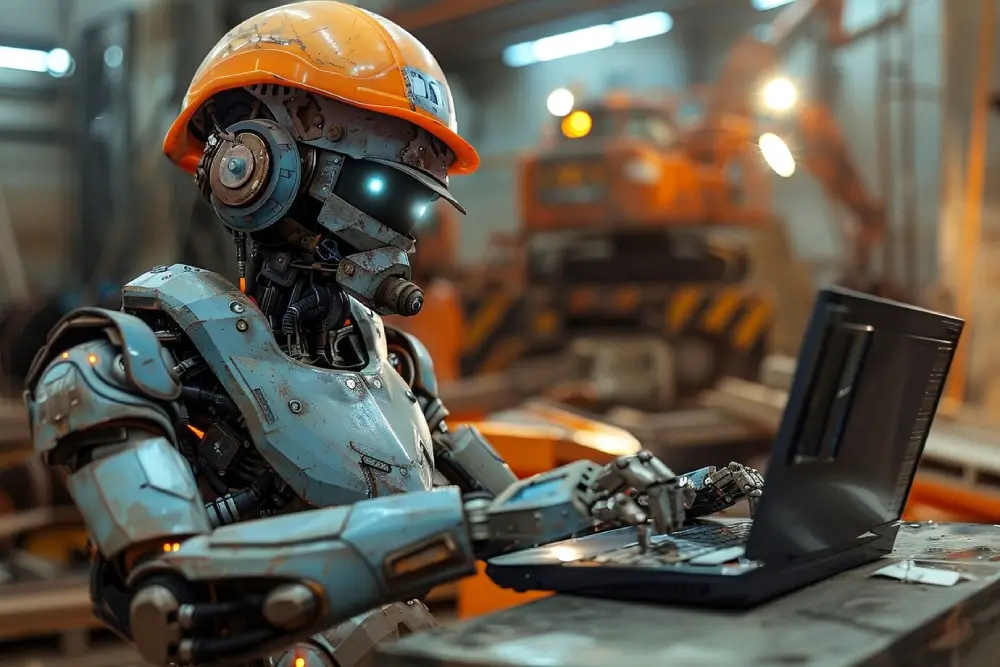
We use cookies and similar technologies that are necessary to operate the website. Additional cookies are used to perform analysis of website usage. please read our Privacy Policy
How AI is Revolutionizing the Mining Industry: A Complete Guide

Mining is a big industry where people dig up valuable things like minerals and metals. But mining isn’t easy. It can be dangerous for workers, and there are challenges like making sure everything runs smoothly and doesn’t harm the environment.
That’s where Artificial Intelligence, or AI, comes in. AI is like really smart computers that can learn and make decisions on their own. And it’s changing how things work in mining.
In this blog, we’ll explore how AI is making a difference in mining. We’ll see how it’s making work safer, operations smoother, and helping to protect the environment. So, let’s dive into the world where technology meets mining!
Traditional Challenges in the Mining Industry
Mining has always been a tough job, filled with challenges that make it difficult for workers and the environment. Let’s take a closer look at some of these challenges:
A. Safety concerns and hazardous working conditions:
Working in mines can be dangerous. Miners face risks like cave-ins, explosions, and harmful gases. Safety measures are crucial, but accidents still happen, making it a top concern for everyone involved.
B. Operational inefficiencies:
Mining operations can be wasteful and inefficient. Sometimes, valuable resources are left behind because it’s too difficult or expensive to extract them. This inefficiency means less profit for mining companies and can harm the environment.
C. Environmental impact and sustainability challenges:
Mining can have a big impact on the environment. It can lead to deforestation, pollution of water sources, and loss of wildlife habitats. Sustainability is about finding ways to mine responsibly, minimizing harm to nature and ensuring resources are available for future generations.
The Role of AI in Mining Industry
Artificial Intelligence (AI) is like a super hero in the mining industry, having the ability to intervene and solve some of the most difficult problems that miners encounter. Let’s examine more closely at the significant impact AI is having:
A. Automation and Robotics in Mining Operations
Imagine giant trucks and machines working tirelessly without needing human drivers. That’s the magic of automation and robotics in mining. With AI, these machines can navigate through rough terrain and haul heavy loads, all on their own. This not only makes mining operations safer but also more efficient.
B. Predictive Maintenance and Asset Optimization
AI doesn’t just wait for things to break down; it predicts when they might and fixes them before they do. This is called predictive maintenance. By analyzing data from sensors and machines, AI can tell miners when equipment needs repairs or maintenance. This saves time and money by preventing costly breakdowns and keeping operations running smoothly.
C. Advanced Data Analytics for Enhanced Decision-Making
Mining generates a ton of data, but it’s not very useful if we can’t make sense of it. That’s where AI steps in. By crunching numbers and analyzing patterns, AI helps miners make smarter decisions. Whether it’s deciding where to dig next or how to optimize production, AI gives miners the insights they need to succeed.
D. Environmental Monitoring and Sustainability Initiatives
Mining can have a big impact on the environment, but AI is helping to minimize that impact. By monitoring air and water quality, predicting the effects of mining activities, and even finding ways to recycle waste, AI is making mining more sustainable. This means we can keep extracting valuable resources without harming the planet.
Benefits of AI in Mining Industry
AI adoption in the mining industry brings several significant benefits that positively impact both the workers and the environment, while also improving the overall efficiency of operations.
A. Improved Safety for Workers
One of the most crucial benefits of using AI in mining is the improved safety it provides for workers. With AI-powered systems, dangerous tasks can be automated, reducing the need for human workers to enter hazardous environments.
For example, autonomous vehicles can navigate through mines without risking the lives of miners. Additionally, AI can analyze data to predict and prevent potential accidents before they occur, creating a safer working environment for everyone involved.
B. Increased Operational Efficiency and Productivity
AI technologies simplify mining operations, leading to increased efficiency and productivity. By automating repetitive tasks and optimizing processes, AI can help mining companies extract resources more effectively and at a lower cost.
For instance, AI-driven algorithms can analyze vast amounts of data to identify the most efficient routes for transporting materials within a mine, minimizing delays and maximizing output. This improved efficiency ultimately translates to higher profitability for mining companies.
C. Minimized Environmental Impact and Better Sustainability Practices
Another significant benefit of AI adoption in mining is the potential to minimize environmental impact and promote better sustainability practices. AI can help mining companies monitor and manage their environmental footprint more effectively by optimizing resource usage and reducing waste.
For example, AI-powered sensors can detect changes in environmental conditions, allowing companies to adjust their operations accordingly to minimize harm to ecosystems. Additionally, AI can assist in the development of more sustainable mining techniques, such as using predictive models to identify areas with higher mineral concentrations, reducing the need for extensive exploration and excavation.
D. Enhanced Decision-Making and Strategic Planning
AI technologies provide mining companies with valuable insights and data-driven decision-making capabilities. By analyzing vast amounts of data in real-time, AI can help mining companies identify trends, anticipate market demand, and make informed strategic decisions.
For example, AI-powered analytics tools can analyze geological data to predict the likelihood of finding valuable minerals in specific locations, enabling companies to allocate resources more efficiently. Furthermore, AI can optimize supply chain management, ensuring that materials are sourced and delivered in a timely and cost-effective manner.
Challenges and Limitations of AI in Mining Industry
While AI brings promising opportunities to the mining industry, there are also some hurdles to overcome.
A. Initial Investment Costs and Technological Integration Challenges
Implementing AI in mining requires a significant initial investment. Buying the necessary equipment and software, as well as setting up the infrastructure, can be expensive. Additionally, integrating AI technologies into existing mining operations may not always be straightforward. It often requires changes to workflows and processes, which can be time-consuming and complex.
B. Workforce Reskilling and Adaptation to AI-Driven Systems
As AI technology becomes more prevalent in mining, workers need to adapt to new ways of working. This may involve learning how to operate and maintain AI-driven systems, as well as understanding the data they produce. Some workers may need to undergo training or reskilling programs to keep up with these changes. Ensuring that employees feel supported in this transition is crucial for the successful implementation of AI in mining.
C. Ethical Considerations and Data Privacy Concerns
AI in mining relies heavily on data collection and analysis. While this can lead to valuable insights and optimizations, it also raises ethical concerns. Mining companies must ensure that the data they collect is used responsibly and ethically. This includes protecting the privacy of individuals whose data is being collected and ensuring that data is not used in ways that could harm communities or the environment. Transparency and accountability are essential to address these concerns and build trust among stakeholders.
Future Trends of AI in Mining Industry
As we look ahead, it’s clear that Artificial Intelligence (AI) will continue to play a significant role in shaping the future of the mining industry. Here are some simple explanations of the trends we can expect to see:
A. More Advanced AI Applications:
Just like how your phone gets smarter with new updates, AI in mining will keep evolving. We’ll see even more advanced applications of AI, like deep learning and neural networks, which can help make mining operations even more efficient.
B. Better Collaboration:
Mining companies and technology providers will work together more closely. By sharing knowledge and resources, they can develop AI tools that are even more effective for improving safety, efficiency, and sustainability in mining.
C. Discovering New Resources:
AI has the potential to help us find new mineral resources that were previously hidden or too difficult to reach. By analyzing huge amounts of data, AI can pinpoint where valuable minerals might be located underground, helping mining companies make better decisions about where to explore.
D. Optimizing Supply Chains:
AI can also help make mining supply chains more efficient. By using AI to track and analyze the movement of materials from mines to processing plants to customers, companies can find ways to save time and money, while also reducing waste and environmental impact.
Conclusion
As we wrap up our exploration of how AI is revolutionizing the mining industry, it’s clear that the future is full with possibilities. With the help of advanced technologies and innovative solutions, mining companies are transforming their operations to be safer, more efficient, and more sustainable than ever before.
The Mining Industry Software Development Company has played a crucial role in this transformation, providing cutting-edge software solutions tailored to the unique challenges of the mining sector. Through their expertise in AI, they have enabled mining companies to harness the power of data, automation, and predictive analytics to drive operational excellence and achieve their business goals.
Read Also:
We are here
Our team is always eager to know what you are looking for. Drop them a Hi!
Zealous Team
Meet the Zealous Team – your dedicated source for cutting-edge insights on the latest technologies, digital transformation, and industry trends. With a passion for innovation and a commitment to delivering unparalleled expertise.
Table of Contents
×

Comments